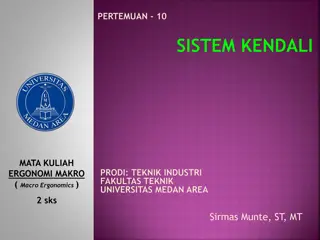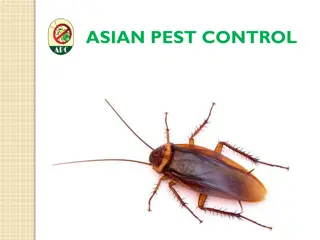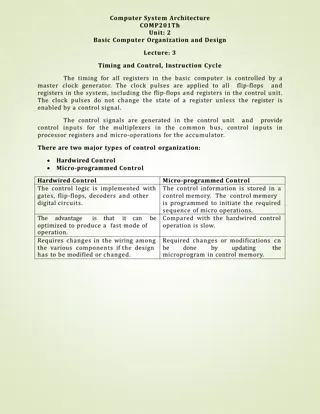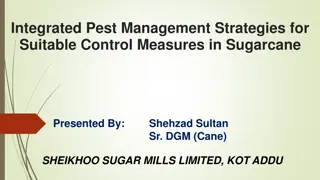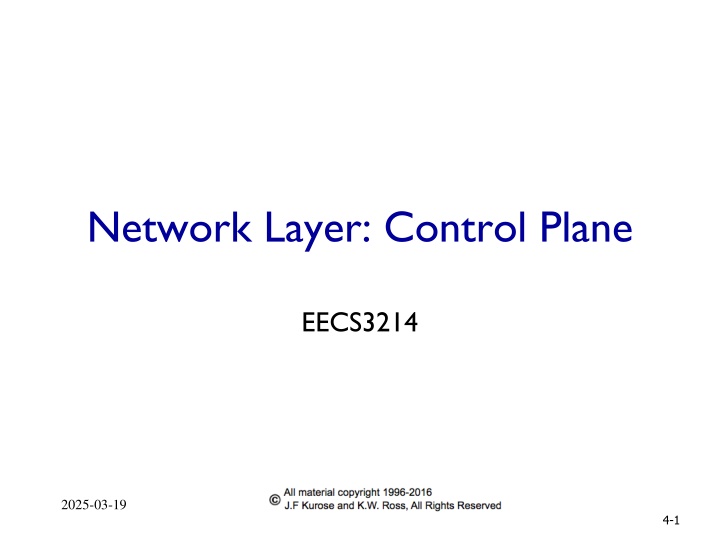
Exploring Network Layer Control Plane in Networking Concepts
Delve into the intricate workings of the network layer control plane, understanding traditional routing algorithms, SDN controllers, Internet Control Message Protocol, and more. Explore the principles behind network control plane implementation, routing protocols like OSPF and BGP, and the role of SDN in modern networking landscapes.
Download Presentation

Please find below an Image/Link to download the presentation.
The content on the website is provided AS IS for your information and personal use only. It may not be sold, licensed, or shared on other websites without obtaining consent from the author. If you encounter any issues during the download, it is possible that the publisher has removed the file from their server.
You are allowed to download the files provided on this website for personal or commercial use, subject to the condition that they are used lawfully. All files are the property of their respective owners.
The content on the website is provided AS IS for your information and personal use only. It may not be sold, licensed, or shared on other websites without obtaining consent from the author.
E N D
Presentation Transcript
Network Layer: Control Plane EECS3214 2025-03-19 4-1
Chapter 5: network layer control plane chapter goals:understand principles behind network control plane traditional routing algorithms SDN controlllers Internet Control Message Protocol network management and their instantiation, implementation in the Internet: OSPF, BGP, ICMP, SNMP Network Layer: Control Plane 5-2
Chapter 5: outline 5.1 introduction 5.2 routing protocols link state distance vector 5.3 intra-AS routing in the Internet: OSPF 5.4 routing among the ISPs: BGP 5.5 The SDN control plane 5.6 ICMP: The Internet Control Message Protocol 5.7 Network management and SNMP Network Layer: Control Plane 5-3
Network-layer functions Recall: two network-layer functions: forwarding: move packets from router s input to appropriate router s output routing: determine route taken by packets from source to destination data plane controlplane Two approaches to structuring network control plane: per-router control (traditional) logically centralized control (software defined networking) Network Layer: Control Plane 5-4
Per-router control plane Individual routing algorithm components in each and every router interact with each other in control plane to compute forwarding tables Routing Algorithm control plane data plane Network Layer: Control Plane 5-5
Logically centralized control plane A distinct (typically remote) controller interacts with local control agents (CAs) in routers to compute forwarding tables Remote Controller control plane data plane CA CA CA CA CA Network Layer: Control Plane 5-6
Chapter 5: outline 5.1 introduction 5.2 routing protocols link state distance vector 5.3 intra-AS routing in the Internet: OSPF 5.4 routing among the ISPs: BGP 5.5 The SDN control plane 5.6 ICMP: The Internet Control Message Protocol 5.7 Network management and SNMP Network Layer: Control Plane 5-7
Routing protocols Routing protocol goal:determine good paths (equivalently, routes), from sending hosts to receiving host, through network of routers path: sequence of routers packets will traverse in going from given initial source host to given final destination host good : least cost , fastest , least congested routing: a top-10 networking challenge! Network Layer: Control Plane 5-8
Graph abstraction of the network 5 3 v w 5 2 u z 2 1 3 1 2 x y 1 graph: G = ( V, E ) V = set of routers = { u, v, w, x, y, z } E = set of links ={ (u,v), (u,x), (v,x), (v,w), (x,w), (x,y), (w,y), (w,z), (y,z) } aside: graph abstraction is useful in other network contexts, e.g., P2P, where V is set of peers and E is set of TCP connections Network Layer: Control Plane 5-9
Graph abstraction: costs 5 c(x,x ) = cost of link (x,x ) e.g., c(w,z) = 5 3 v w 5 2 cost could always be one (hop), or inversely related to bandwidth, or inversely related to congestion u z 2 1 3 1 2 x y 1 cost of path (x1, x2, x3, , xp) = c(x1,x2) + c(x2,x3) + + c(xp-1,xp) key question: what is the least-cost path between u and z ? routing algorithm: algorithm that finds that least cost path Network Layer: Control Plane 5-10
Routing algorithm classification Q: static or dynamic? Q: global or decentralized information? global: all routers have complete topology, link cost info link state algorithms decentralized: router knows physically- connected neighbors, link costs to neighbors iterative process of computation, exchange of info with neighbors distance vector algorithms static: routes change slowly over time dynamic: routes change more quickly periodic updates in response to link cost changes more responsive but more route oscillation; routing loops Network Layer: Control Plane 5-11
Chapter 5: outline 5.1 introduction 5.2 routing protocols link state distance vector 5.3 intra-AS routing in the Internet: OSPF 5.4 routing among the ISPs: BGP 5.5 The SDN control plane 5.6 ICMP: The Internet Control Message Protocol 5.7 Network management and SNMP Network Layer: Control Plane 5-12
A link-state routing algorithm Dijkstra s algorithm net topology, link costs known to all nodes accomplished via link state broadcast all nodes have same info computes least cost paths from one node ( source ) to all other nodes gives forwarding table for that node iterative: after k iterations, know least cost paths to k destinations Notation: c(x,y): link cost from node x to y; = if not direct neighbors D(v): current value of cost of path from source to destination v p(v): predecessor node along path from source to destination v N': set of nodes whose least cost paths definitively known Network Layer: Control Plane 5-13
Dijsktras algorithm 1 Initialization: 2 N' = {u} 3 for all nodes v 4 if v adjacent to u 5 then D(v) = c(u,v) 6 else D(v) = 7 8 Loop 9 find w not in N' such that D(w) is a minimum 10 add w to N' 11 update D(v) for all v adjacent to w and not in N' : 12 D(v) = min( D(v), D(w) + c(w,v) ) 13 /* new cost to v is either old cost to v or known 14 shortest path cost to w plus cost from w to v */ 15 until all nodes in N' Network Layer: Control Plane 5-14
Dijkstras algorithm: example D(v) p(v) 7,u 6,w 6,w D(w) p(w) 3,u D(x) p(x) 5,u 5,u D(y) p(y) D(z) p(z) Step 0 1 2 3 4 5 N' u uw uwx uwxv uwxvy uwxvyz 11,w 11,w 10,v 14,x 14,x 12,y x 9 notes: construct shortest path tree by tracing predecessor nodes ties can exist (can be broken arbitrarily) 7 5 4 8 3 w z y u 2 3 4 7 v Network Layer: Control Plane 5-15
Dijkstras algorithm: another example D(v),p(v) D(x),p(x) D(w),p(w) D(y),p(y) Step N' u ux uxy uxyv uxyvw uxyvwz D(z),p(z) 4,y 4,y 4,y 2,u 2,u 2,u 1,u 5,u 4,x 3,y 3,y 0 1 2 3 4 5 2,x 5 3 v w 5 2 u z 2 1 3 1 2 x y 1 * Check out the online interactive exercises for more examples: http://gaia.cs.umass.edu/kurose_ross/interactive/ Network Layer: Control Plane 5-16
Dijkstras algorithm: example (2) resulting shortest-path tree from u: v w u z x y resulting forwarding table in u: destination link (u,v) (u,x) v x y w z (u,x) (u,x) (u,x) Network Layer: Control Plane 5-17
Dijkstras algorithm, discussion algorithm complexity:n nodes each iteration: need to check all nodes, w, not in V n(n+1)/2 comparisons: O(n2) more efficient implementation using a heap: O(nlogn) oscillations possible: e.g., support link cost equals amount of carried traffic A A A A 1 1+e 2+e 2+e 0 2+e 0 0 D B D D D B B B 0 0 1+e 1 1+e 1 0 0 e 0 0 0 C 0 1 0 C C C 1+e 1 1 e given these costs, find new routing . resulting in new costs given these costs, find new routing . resulting in new costs given these costs, find new routing . resulting in new costs initially Network Layer: Control Plane 5-18
Chapter 5: outline 5.1 introduction 5.2 routing protocols link state distance vector 5.3 intra-AS routing in the Internet: OSPF 5.4 routing among the ISPs: BGP 5.5 The SDN control plane 5.6 ICMP: The Internet Control Message Protocol 5.7 Network management and SNMP Network Layer: Control Plane 5-19
Distance vector algorithm Bellman-Ford equation (dynamic programming) Let dx(y) := cost of least-cost path from x to y then dx(y) = min {c(x,v) + dv(y) } v cost from neighbor v to destination y cost to neighbor v min taken over all neighbors v of x Network Layer: Control Plane 5-20
Bellman-Ford example Compute cost from u to z: Clearly, dv(z) = 5, dx(z) = 3, dw(z) = 3 5 3 v w 5 2 B-F equation says: u z 2 1 3 du(z) = min { c(u,v) + dv(z), c(u,x) + dx(z), c(u,w) + dw(z) } = min {2 + 5, 1 + 3, 5 + 3} = 4 1 2 x y 1 Node achieving minimum is next hop in shortest path, used in forwarding table Network Layer: Control Plane 5-21
Distance vector algorithm: variables Dx(y) = estimate of least cost from x to y x maintains distance vector Dx = [Dx(y): y V ] node x: knows cost to each neighbor v: c(x,v) maintains its neighbors distance vectors. For each neighbor v, x maintains Dv = [Dv(y): y V ] Network Layer: Control Plane 5-22
Distance vector algorithm: key idea key idea: from time-to-time, each node sends its own distance vector estimate to neighbors when x receives new DV estimate from neighbor, it updates its own DV using B-F equation: Dx(y) minv{c(x,v) + Dv(y)} for each node y V under minor, natural conditions, the estimate Dx(y) converge to the actual least cost dx(y) Network Layer: Control Plane 5-23
Distance vector algorithm: properties each node: iterative, asynchronous: each local iteration caused by: local link cost change DV update message from neighbor distributed: each node notifies neighbors only when its DV changes neighbors then notify their neighbors if necessary wait for (change in local link cost or msg from neighbor) recompute estimates if DV to any dest has changed, notify neighbors Network Layer: Control Plane 5-24
Dx(z) = min{c(x,y) + Dy(z), c(x,z) + Dz(z)} = min{2+1 , 7+0} = 3 Dx(y) = min{c(x,y) + Dy(y), c(x,z) + Dz(y)} = min{2+0 , 7+1} = 2 node x table cost to cost to x y z 0 2 7 x y z 0 2 0 1 7 1 0 x y z x y z 3 2 from from node y table cost to y x y z 2 1 x y z z 2 0 1 x 7 from node z table cost to x y z x y z from 7 1 0 time Network Layer: Control Plane 5-25
Dx(z) = min{c(x,y) + Dy(z), c(x,z) + Dz(z)} = min{2+1 , 7+0} = 3 Dx(y) = min{c(x,y) + Dy(y), c(x,z) + Dz(y)} = min{2+0 , 7+1} = 2 node x table cost to cost to cost to x y z 0 2 7 x y z 0 2 0 1 7 1 0 x y z 0 2 3 2 0 1 3 1 0 x y z x y z 3 2 x y z from from from node y table cost to cost to cost to y x y z x y z 0 2 7 2 0 1 7 1 0 x y z 0 2 3 2 0 1 3 1 0 2 1 x y z x y z 2 0 1 z x y z x 7 from from from node z table cost to cost to cost to x y z 0 2 7 2 0 1 3 1 0 x y z 0 2 3 2 0 1 x y z x y z x y z x y z from from from 7 1 0 3 1 0 time time Network Layer: Control Plane 5-26
Distance vector: link cost changes link cost changes: node detects local link cost change updates routing info, recalculates distance vector if DV changes, notify neighbors 1 y 4 1 x z 50 good news travels fast t0 : y detects link-cost change, updates its DV, informs its neighbors. t1 : z receives update from y, updates its table, computes new least cost to x , sends its neighbors its DV. t2 : y receives z s update, updates its distance table. y s least costs do not change, so y does not send a message to z. * Check out the online interactive exercises for more examples: http://gaia.cs.umass.edu/kurose_ross/interactive/ Network Layer: Control Plane 5-27
Distance vector: link cost changes (2) link cost changes: node detects local link cost change bad news travels slow - count to infinity problem! 44 iterations before algorithm stabilizes: see text 60 y 4 1 x z 50 poisoned reverse: If Z routes through Y to get to X : Z tells Y its (Z s) distance to X is infinite (so Y won t route to X via Z) will this completely solve count to infinity problem? Network Layer: Control Plane 5-28
Comparison of LS and DV algorithms message complexity LS: with n nodes, E links, O(nE) messages sent DV: exchange between neighbors only convergence time varies speed of convergence LS: O(n2) algorithm requires O(nE) messages may have oscillations DV: convergence time varies may cause routing loops count-to-infinity problem robustness: what happens if router malfunctions? LS: node can advertise incorrect link cost each node computes only its own table DV: DV node can advertise incorrect path cost each node s table used by others errors propagate through network Network Layer: Control Plane 5-29
Chapter 5: outline 5.1 introduction 5.2 routing protocols link state distance vector 5.3 intra-AS routing in the Internet: OSPF 5.4 routing among the ISPs: BGP 5.5 The SDN control plane 5.6 ICMP: The Internet Control Message Protocol 5.7 Network management and SNMP Network Layer: Control Plane 5-30
Making routing scalable our routing study thus far - idealized all routers identical network flat not true in practice scale: with billions of destinations: can t store all destinations in routing tables! routing table exchange would swamp links! administrative autonomy internet = network of networks each network administrator may want to control routing in their own network Network Layer: Control Plane 5-31
Internet approach to scalable routing Aggregate routers into regions known as autonomous systems (AS) (a.k.a. domains ) intra-AS routing routing among hosts, routers in same AS ( network ) all routers in AS must run same intra-domain protocol routers in different AS can run different intra-domain routing protocols gateway router: at edge of its own AS, has link(s) to router(s) in other AS es inter-AS routing routing among AS es gateways perform inter- domain routing (as well as intra-domain routing) Network Layer: Control Plane 5-32
Interconnected ASes 3c 3a 2c 3b 2a AS3 2b 1c AS2 1a 1b AS1 forwarding table configured by both intra- and inter-AS routing algorithms intra-AS routing determine entries for destinations within AS inter-AS and intra-AS determine entries for external destinations 1d Intra-AS Routing algorithm Inter-AS Routing algorithm Forwarding table Network Layer: Control Plane 5-33
Inter-AS tasks suppose router in AS1 receives datagram destined outside of AS1: router should forward packet to gateway router, but which one? AS1 must: 1. learn which destinations are reachable through AS2, which through AS3 2. propagate this reachability info to all routers in AS1 job of inter-AS routing! 3c 3a 3b 2c AS3 other networks 1c 2a 2b other networks 1a 1b AS2 1d AS1 Network Layer: Control Plane 5-34
Intra-AS Routing also known as interior gateway protocols (IGP) most common intra-AS routing protocols: RIP: Routing Information Protocol OSPF: Open Shortest Path First (IS-IS protocol essentially same as OSPF) IS: Intermediate System IGRP: Interior Gateway Routing Protocol (Cisco proprietary for decades, until 2016) Network Layer: Control Plane 5-35
OSPF (Open Shortest Path First) open : publicly available uses link-state algorithm link state packet dissemination topology map at each node route computation using Dijkstra s algorithm router floods OSPF link-state advertisements to all other routers in entire AS link state: for each attached link carried in OSPF messages directly over IP (rather than TCP or UDP) IS-IS routing protocol: nearly identical to OSPF Network Layer: Control Plane 5-36
OSPF: More Details Carries OSPF messages directly over IP protocol 89 supports reliable message transfer supports link state broadcast Checks if links are operational sending HELLO messages Obtains link-state database from neighbor routers OSPF messages are sent if link states change periodically (30 minutes) 4-37 Network Layer
OSPF advanced features security: all OSPF messages authenticated (to prevent malicious intrusion) multiple same-cost paths allowed (only one path allowed in RIP) integrated unicast and multicast support: Multicast OSPF (MOSPF, RFC 1584) uses same topology database as OSPF hierarchical OSPF in large domains Network Layer: Control Plane 5-38
Hierarchical OSPF boundary router backbone router backbone area border routers area 3 internal routers area 1 area 2 Network Layer: Control Plane 5-39
Hierarchical OSPF two-level hierarchy: local area, backbone. link-state advertisements only in area each nodes has detailed area topology, but only knows direction (shortest path) to networks in other areas. area border routers: summarize distances to networks in its own area; advertise this info to other area border routers. backbone routers: run OSPF routing within the backbone. boundary routers: connect to other AS es. Network Layer: Control Plane 5-40
Hierarchical OSPF Routing Packet routing within a domain: local router > area border router (intra-area) > backbone router(s) > area border router of destination network > destination local router Inter-AS routing: local router > area border router (intra-area) > backbone router(s) > boundary router > another AS 4-41 Network Layer
Chapter 5: outline 5.1 introduction 5.2 routing protocols link state distance vector 5.3 intra-AS routing in the Internet: OSPF 5.4 routing among the ISPs: BGP 5.5 The SDN control plane 5.6 ICMP: The Internet Control Message Protocol 5.7 Network management and SNMP Network Layer: Control Plane 5-42
Internet inter-AS routing: BGP BGP (Border Gateway Protocol)(RFC 4271): the de facto inter-domain routing protocol glue that holds the Internet together BGP provides each AS a means to: eBGP: obtain subnet reachability information from neighboring AS es (gateway routers) iBGP: propagate reachability information to all AS- internal routers. determine good routes to other networks based on reachability information and policy allows subnet to advertise its existence to the rest of Internet: I am here Network Layer: Control Plane 5-43
BGP Forwarding Tables Packets routed using CIDRized prefixes, e.g., 138.16.68/22 Forwarding table entries have the form (prefix, interface) 4-44 Network Layer
eBGP, iBGP connections 2b 2a 2c 1b 3b 2d 1a 1c 3a 3c AS 2 1d 3d AS 1 eBGP connection iBGP connection AS 3 gateway routers run both eBGP and iBGP protocols 1c Other routers: internal routers Network Layer: Control Plane 5-45
BGP basics BGP connection: two BGP routers ( peers ) exchange BGP messages over a semi-permanent TCP connection (port 179): advertising paths to different destination network prefixes (BGP is a path vector protocol) when AS3 gateway router 3a advertises path AS3,X to AS2 gateway router 2c: AS3 promises to AS2 it will forward datagrams towards X AS 3 3b AS 1 1b 3a 3c 1a 1c AS 2 2b X 3d 1d BGP advertisement: AS3, X 2a 2c 2d Network Layer: Control Plane 5-46
BGP path advertisement AS3 3b AS1 1b 3a 3c 1a 1c AS2 2b X 3d 1d AS3,X AS2,AS3,X 2a 2c 2d AS2 router 2c receives path advertisement AS3, X (via eBGP) from AS3 router 3a Based on AS2 policy, AS2 router 2c accepts path AS3,X, propagates (via iBGP) to all AS2 routers Based on AS2 policy, AS2 router 2a advertises (via eBGP) path AS2, AS3, X to AS1 router 1c Network Layer: Control Plane 5-47
BGP path advertisement (2) AS3 3b AS1 1b 3a 3c 1a 1c AS2 2b X 3d 1d AS3,X AS2,AS3,X 2a 2c 2d gateway router may learn about multiple paths to destination: AS1 gateway router 1c learns path AS2,AS3,X from 2a AS1 gateway router 1c learns path AS3,X from 3a Based on policy, AS1 gateway router 1c chooses path AS3,X, and advertises path within AS1 via iBGP Network Layer: Control Plane 5-48
Path attributes and BGP routes advertised prefix includes BGP attributes prefix + attributes = route two important attributes: AS-PATH: list of ASes through which prefix advertisement has passed NEXT-HOP: IP addresses of the router interface that begins the AS-PATH Network Layer: Control Plane 5-49
BGP, OSPF, forwarding table entries Q: how does router set forwarding table entry to distant prefix? AS3 3b AS1 1b 1 3a 3c 1a 1c 2 AS2 local link interfaces at 1a, 1d 2b X 3d 1 2 1d AS3,X AS2,AS3,X 2a 2c physical link 2d dest interface X recall: 1a, 1b, 1c learn about dest X via iBGP from 1c: path to X goes through 1c 1d: OSPF intra-domain routing: to get to 1c, forward over outgoing local interface 1 1 Network Layer: Control Plane 5-50



